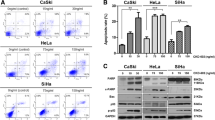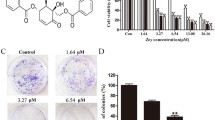Abstract
Several in vitro studies along with some in vivo studies have shown the anti-cancer activity of bromelain against several types of cancer except cervical cancer. This study is focused to address the therapeutic effect of bromelain on a human cervical cancer cell line in vitro using HeLa cells. Here, the IC50 dose of bromelain enhanced Hela cell apoptosis at a concentration of 100 μg/ml after 48 h treatment, which is statistically significant compared to the dose of 50 μg/ml (p < 0.01). The percentage of live cells was reduced to about 48% and the percentage of apoptotic cells has increased to about 47% at the IC50 dose of bromelain with a 48 h exposure. Significant proportions of HeLa cells were observed to undergo apoptosis via the p53-dependent pathway in a ROS-independent manner at 100 μg/ml after 48 h treatment. In addition to that, bromelain also inhibited the formation of colonies and the migratory ability of HeLa cells. The present study reports that bromelain can act in an apoptotic pathway on human cervical cancer cell line HeLa.






Similar content being viewed by others
Abbreviations
- AO:
-
Acridine orange
- DAPI:
-
4′,6-Diamidino-2-phenylindole
- DMEM:
-
Dulbeccos modified eagle medium
- DMSO:
-
Dimethyl sulfoxide
- EDTA:
-
Ethylenediaminetetraacetic acid
- EtBr:
-
Ethidium bromide
- FITC:
-
Fluorescein isothiocyanate
- HRP:
-
Horseradish peroxidase
- MTT:
-
3-(4,5-Dimethylthiazol-2-yl)-2,5-diphenyl tetrazolium bromide
- NBT:
-
Nitroblue tetrazolium
- NFDM:
-
Non fat dry milk
- PI:
-
Propidium iodide
- ROS:
-
Reactive oxygen species
References
Amini A, Ehteda A, Moghaddam SM, Akhter J, Pillai K, Morris DL (2013) Cytotoxic effects of bromelain in human gastrointestinal carcinoma cell lines (MKN45, KATO-III, HT29-5F12, and HT29-5M21). Onco Targets Ther 6:403
Amini A, Masoumi-Moghaddam S, Ehteda A, Morris DL (2014) Bromelain and N-acetylcysteine inhibit proliferation and survival of gastrointestinal cancer cells in vitro: significance of combination therapy. J Exp Clin Cancer Res 33:1–15
Báez R, Lopes MT, Salas CE, Hernandez M (2007) In vivo antitumoral activity of stem pineapple (Ananas comosus) bromelain. Planta Med 73:1377–1383
Bhatnagar P, Patnaik S, Srivastava AK, Mudiam MK, Shukla Y, Panda AK, Pant AB, Kumar P, Gupta KC (2014) Anti-cancer activity of bromelain nanoparticles by oral administration. J Biomed Nanotechnol 10:3558–3575
Bhattacharyya BK (2008) Bromelain: an overview
Bhui K, Tyagi S, Prakash B, Shukla Y (2010) Pineapple bromelain induces autophagy, facilitating apoptotic response in mammary carcinoma cells. BioFactors 36:474–482
Bhui K, Tyagi S, Srivastava AK, Singh M, Roy P, Singh R, Shukla Y (2012) Bromelain inhibits nuclear factor kappa-B translocation, driving human epidermoid carcinoma A431 and melanoma A375 cells through G2/M arrest to apoptosis. Mol Carcinog 51:231–243
Chang T-C, Wei P-L, Makondi PT, Chen W-T, Huang C-Y, Chang Y-J (2019) Bromelain inhibits the ability of colorectal cancer cells to proliferate via activation of ROS production and autophagy. PLoS ONE 14:e0210274
Davalos AR, Coppe J-P, Campisi J, Desprez P-Y (2010) Senescent cells as a source of inflammatory factors for tumor progression. Cancer Metastasis Rev 29:273–283
Dhandayuthapani S, Perez HD, Paroulek A, Chinnakkannu P, Kandalam U, Jaffe M, Rathinavelu A (2012) Bromelain-induced apoptosis in GI-101A breast cancer cells. J Med Food 15:344–349
Evan GI, Vousden KH (2001) Proliferation, cell cycle and apoptosis in cancer. Nature 411:342–348
Franken NA, Rodermond HM, Stap J, Haveman J, Van Bree C (2006) Clonogenic assay of cells in vitro. Nat Protoc 1:2315–2319
Gani MBA, Nasiri R, Hamzehalipour Almaki J, Majid FAA, Marvibaigi M, Amini N, Chermahini SH, Mashudin M (2015a) In vitro antiproliferative activity of fresh pineapple juices on ovarian and colon cancer cell lines. Int J Peptide Res Therapeut 21:353–364
Gani MBA, Nasiri R, Almaki JH, Majid FAA, Marvibaigi M, Amini N, Chermahini SH, Mashudin M (2015b) In vitro antiproliferative activity of fresh pineapple juices on ovarian and colon cancer cell lines. Int J Pept Res Ther 21:353–364
Gautam S, Mishra S, Dash V, Goyal AK, Rath G (2010) Comparative study of extraction, purification and estimation of bromelain from stem and fruit of pineapple plant, Thai J Pharm Sci, 34
Hale LP (2004) Proteolytic activity and immunogenicity of oral bromelain within the gastrointestinal tract of mice. Int Immunopharm 4:255–264
Han D, Haudenschild CC, Hong MK, Tinkle BT, Leon MB, Liau G (1995) Evidence for apoptosis in human atherogenesis and in a rat vascular injury model. Am J Pathol 147:267
Hann SS, Zheng F, Zhao S (2013) Targeting 3-phosphoinositide-dependent protein kinase 1 by N-acetyl-cysteine through activation of peroxisome proliferators activated receptor alpha in human lung cancer cells, the role of p53 and p65. J Exp Clin Cancer Res 32:43
Hollstein M, Sidransky D, Vogelstein B, Harris CC (1991) p53 mutations in human cancers. Science 253:49–53
Hou D-X, Uto T, Tong X, Takeshita T, Tanigawa S, Imamura I, Ose T, Fujii M (2004) Involvement of reactive oxygen species-independent mitochondrial pathway in gossypol-induced apoptosis. Arch Biochem Biophys 428:179–187
Huai Y, Zhang Y, Xiong X, Das S, Bhattacharya R, Mukherjee P (2019) Gold Nanoparticles sensitize pancreatic cancer cells to gemcitabine. Cell Stress 3:267
Kelly GS (1996) Bromelain: a literature review and discussion of its therapeutic applications, In: Alternative Medicine Review, Citeseer.
Ko CH, Shen S-C, Hsu C-S, Chen Y-C (2005) Mitochondrial-dependent, reactive oxygen species-independent apoptosis by myricetin: roles of protein kinase C, cytochrome c, and caspase cascade. Biochem Pharmacol 69:913–927
Kuilman T, Michaloglou C, Mooi WJ, Peeper DS (2010) The essence of senescence. Genes Dev 24:2463–2479
Lee JH, Lee JT, Park HR, Kim JB (2019) The potential use of bromelain as a natural oral medicine having anticarcinogenic activities. Food Sci Nutr 7:1656–1667
Lin S, Fujii M, Hou D-X (2003) Rhein induces apoptosis in HL-60 cells via reactive oxygen species-independent mitochondrial death pathway. Arch Biochem Biophys 418:99–107
Liu K, Liu P-C, Liu R, Wu X (2015) Dual AO/EB staining to detect apoptosis in osteosarcoma cells compared with flow cytometry. Med Sci Monit Basic Res 21:15
Lowe SW, Ruley HE, Jacks T, Housman DE (1993) p53-dependent apoptosis modulates the cytotoxicity of anticancer agents. Cell 74:957–967
Mantovani A, Allavena P, Sica A, Balkwill F (2008) Cancer-related inflammation. Nature 454:436–444
Maurer H (2001) Bromelain: biochemistry, pharmacology and medical use. Cell Molecular Life Sci CMLS 58:1234–1245
Mizutani H, Tada-Oikawa S, Hiraku Y, Kojima M, Kawanishi S (2005) Mechanism of apoptosis induced by doxorubicin through the generation of hydrogen peroxide. Life Sci 76:1439–1453
Mosmann T (1983) Rapid colorimetric assay for cellular growth and survival: application to proliferation and cytotoxicity assays. J Immunol Methods 65:55–63
Mynott TL, Ladhams A, Scarmato P, Engwerda CR (1999) Bromelain, from pineapple stems, proteolytically blocks activation of extracellular regulated kinase-2 in T cells. J Immunol 163:2568–2575
Pal A, Das S (2013) Chronic morphine exposure and its abstinence alters dendritic spine morphology and upregulates Shank1. Neurochem Int 62:956–964
Pal A, Das S (2015) Morphine causes persistent induction of nitrated neurofilaments in cortex and subcortex even during abstinence. Neuroscience 291:177–188
Pal A, Chakraborty J, Das S (2014) Association of CREB1 gene polymorphism with drug seeking behaviour in eastern Indian addicts. Neurosci Lett 570:53–57
Panzarini E, Inguscio V, Dini L (2011) Timing the multiple cell death pathways initiated by Rose Bengal acetate photodynamic therapy. Cell Death Dis 2:e169–e169
Pauzi AZM, Yeap SK, Abu N, Lim KL, Omar AR, Aziz SA, Chow ALT, Subramani T, Tan SG, Alitheen NB (2016) Combination of cisplatin and bromelain exerts synergistic cytotoxic effects against breast cancer cell line MDA-MB-231 in vitro. Chinese Med 11:1–11
Pillai K, Akhter J, Chua TC, Morris DL (2013) Anticancer property of bromelain with therapeutic potential in malignant peritoneal mesothelioma. Cancer Invest 31:241–250
Rowan AD, Buttle DJ (1994) [38] Pineapple cysteine endopeptidases, In: Methods in enzymology, Elsevier, pp. 555–568.
Roy DN, Mandal S, Sen G, Biswas T (2009) Superoxide anion mediated mitochondrial dysfunction leads to hepatocyte apoptosis preferentially in the periportal region during copper toxicity in rats. Chem Biol Interact 182:136–147
Roy D, Mandal S, Sen G, Mukhopadhyay S, Biswas T (2010) 14-Deoxyandrographolide desensitizes hepatocytes to tumour necrosis factor-alpha-induced apoptosis through calcium-dependent tumour necrosis factor receptor superfamily member 1A release via the NO/cGMP pathway. Br J Pharm 160:1823–1843
Roy DN, Sen G, Chowdhury KD, Biswas T (2011) Combination therapy with andrographolide and d-penicillamine enhanced therapeutic advantage over monotherapy with d-penicillamine in attenuating fibrogenic response and cell death in the periportal zone of liver in rats during copper toxicosis. Toxicol Appl Pharm 250:54–68
Sarkar FH, Li Y (2004) Cell signaling pathways altered by natural chemopreventive agents. Mutation Res/fundamental and Molecular Mech Mutagenesis 555:53–64
Satoh M, Kashihara N, Fujimoto S, Horike H, Tokura T, Namikoshi T, Sasaki T, Makino H (2003) A novel free radical scavenger, edarabone, protects against cisplatin-induced acute renal damage in vitro and in vivo. J Pharm Exp Ther 305:1183–1190
Secor ER, Szczepanek SM, Singh A, Guernsey L, Natarajan P, Rezaul K, Han DK, Thrall RS, Silbart LK (2012) LC-MS/MS identification of a bromelain peptide biomarker from Ananas comosus Merr, Evidence-Based Complementary and Alternative Medicine, 2012
Senft C, Polacin M, Priester M, Seifert V, Kögel D, Weissenberger J (2010) The nontoxic natural compound Curcumin exerts anti-proliferative, anti-migratory, and anti-invasive properties against malignant gliomas. BMC Cancer 10:1–8
Taussig SJ, Batkin S (1988) Bromelain, the enzyme complex of pineapple (Ananas comosus) and its clinical application. An update. J Ethnopharm 22:191–203
Taussig S, Szekerczes J, Batkin S (1985) Inhibition of tumour growth in vitro by bromelain, an extract of the pineapple plant (Ananas comosus). Planta Med 51:538–539
Tsai CM, Perng RP, Chang KT, Venzon D, Gazdar AF (1996) Evaluation of the relative cytotoxic effects of anticancer agents in serum-supplemented versus serum-free media using a tetrazolium colorimetric assay. Jpn J Cancer Res 87:91–97
Tysnes BB, Maurert HR, Porwol T, Probst B, Bjerkvig R, Hoover F (2001) Bromelain reversibly inhibits invasive properties of glioma cells. Neoplasia 3:469–479
Wang Y, Rao VK, Kok WK, Roy DN, Sethi S, Ling BMT, Lee MBH, Taneja R (2012) SUMO modification of Stra13 is required for repression of cyclin D1 expression and cellular growth arrest
Yang M-Y, Chang C-J, Chen L-Y (2017) Blue light induced reactive oxygen species from flavin mononucleotide and flavin adenine dinucleotide on lethality of HeLa cells. J Photochem Photobiol, B 173:325–332
Acknowledgements
Authors acknowledge the State Biotech Hub of Tripura and Central Instrumental Facility of Tripura University for providing instruments facility. The authors are also thankful to Prof. Sib Sankar Roy, Indian Institute of Chemical Biology for providing the Flow cytometry facility.
Funding
The work is supported by National Postdoctoral Fellowship (NPDF) [PDF/2016/002726] from the Science and Engineering Research Board (SERB), Department of Science & Technology (DST), Government of India to A.P.
Author information
Authors and Affiliations
Corresponding authors
Ethics declarations
Ethical statement
This article does not contain any studies involving animals performed by any of the authors. This article does not contain any studies involving human participants performed by any of the authors.
Conflict of interest
Ayantika Pal has no conflict of interest. Samir Kumar Sil has no coflict of interest
Additional information
Publisher's Note
Springer Nature remains neutral with regard to jurisdictional claims in published maps and institutional affiliations.
Rights and permissions
About this article
Cite this article
Pal, A., Sil, S.K. Bromelain mediates apoptosis in HeLa cells via ROS-independent pathway. ADV TRADIT MED (ADTM) 23, 605–616 (2023). https://doi.org/10.1007/s13596-022-00638-2
Received:
Accepted:
Published:
Issue Date:
DOI: https://doi.org/10.1007/s13596-022-00638-2




